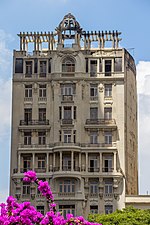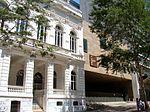Martinelli Building

The Martinelli Building (in Portuguese: Edifício Martinelli), with 28 floors, is the first skyscraper built in Brazil. Located in São Paulo, it is 105 meters tall. The building was planned in 1922 by the Italian-born entrepreneur, Giuseppe Martinelli. Construction began in 1924, and was completed in 1929. At the time of its opening, it was the tallest building in Latin America, and the largest concrete-framed building in the world.The building was completely remodeled by Mayor Olavo Setúbal from 1975 to 1979. Today, the building houses the Departments of Municipal Housing and planning, companies Emurb and Cohab-SP, the headquarters of the Association of Banks of SP, and several shops on the ground floor of the building.
Excerpt from the Wikipedia article Martinelli Building (License: CC BY-SA 3.0, Authors, Images).Martinelli Building
Avenida São João, São Paulo Sé
Geographical coordinates (GPS) Address Website External links Nearby Places Show on map
Geographical coordinates (GPS)
| Latitude | Longitude |
|---|---|
| N -23.545555555556 ° | E -46.635194444444 ° |
Address
Edifício Martinelli
Avenida São João 35
01010-001 São Paulo, Sé
São Paulo, Brazil
Open on Google Maps











